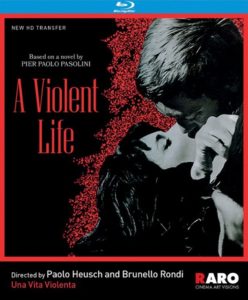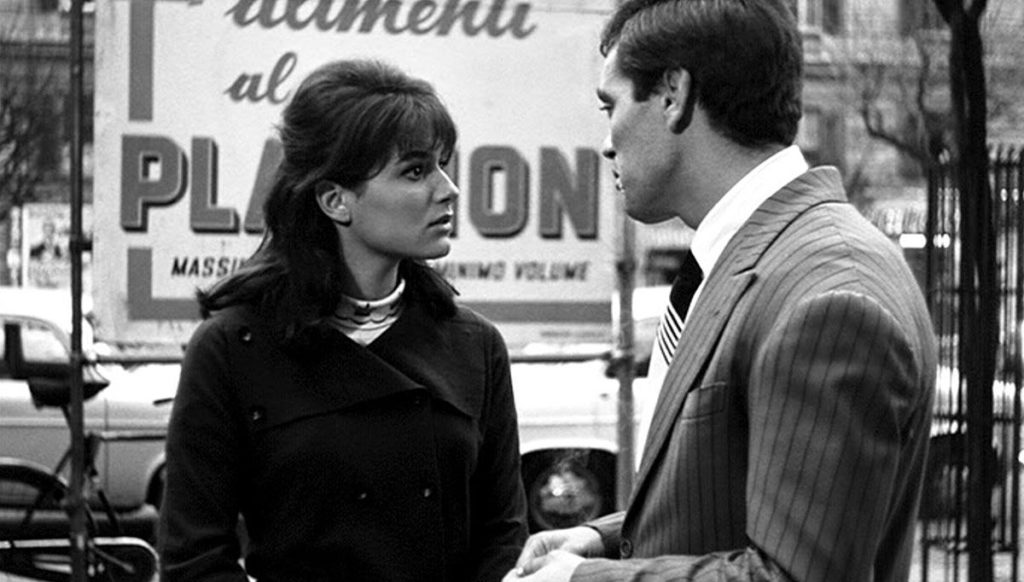From the Pages of Pasolini comes this tale of Desperate Criminal life
DIRECTED BY PAOLO HEUSCH & BRUNELLO RONDI/ITALIAN/1962
BLU-RAY STREET DATE: JANUARY 31, 2023/RARO VIDEO via KINO LORBER

Based on Pier Paolo Pasolini’s novel of the same, A Violent Life (Una Vita Violenta) is a rarely seen Italian film from 1962 that will soon be released (on 1/31/23) by Raro Video, distributed by Kino Lorber. It’s that Pasolini connection that caught my attention, and it will doubtlessly prove to be the main draw for viewers who are intrigued to see another variation on themes explored in his early works Accattone and Mamma Roma.
Though it can’t be fully regarded as a Pasolini film due to his lack of directorial involvement, A Violent Life is clearly infused with his vision, his interests and his passionate advocacy for the outcasts and misfits of Italian society. The source novel was published in 1959, just before Pasolini made his transition into cinema but well after he had first made his name as a poet, author and public intellectual in the earlier years of that decade. The story focuses on the misadventures of a young man named Tomasso who was raised in the rough and tumble suburbs on the outer city limits of Rome. At a time when a growing number of Italians were beginning to experience the pleasures of la dolce vita for themselves, Pasolini’s novel served as a disturbing reminder that many others were being passed over or aggressively consumed by the political and economic forces that produced the so-called “economic miracle” of the 1950s.
The numerous angles from which this social transformation could be considered informed quite a few exceptional Italian films from this era, involving a diverse range of directors including Federico Fellini, Michelangelo Antonioni, Luchino Visconti, Ermanno Olmi and others. The two early Pasolini films mentioned above belong in that illustrious company. While I can’t quite make the case that A Violent Life rises to that level, it does offer more than its share of compelling moments, memorable scenes and imagery, and a strong performance from lead actor Franco Citti who in a sense recapitulates in this film his titular role in Accattone. Both films feature him as a handsomely charismatic, ethically compromised, and ultimately doomed young man who aspires to overcome the adverse hand that life has dealt him, makes strides along a path that might lead to redemption, only to be undone by the cruelties of fate and his own desperate efforts to beat the odds stacked against him. Along the way, there are several segments that function as potentially scandalous exposes of the grim living conditions still too prevalent in a nation that seems to be fixed on prematurely celebrating its triumphs while remaining bogged down with blindspots of ignorance and apathy.

Citti went on to be a frequent contributor to many Pasolini films over the course of the next decade, and his face might also be familiar to many from appearing in the Sicilian scenes of Francis Ford Coppola’s Godfather trilogy. I think it’s fair to say that A Violent Life got dismissed fairly early on after it was released because it could be seen as somewhat derivative of Accattone, which was actually shot afterwards but released earlier due to the vicissitudes of post-production. And in objective terms, it simply doesn’t have the same glow and polish that Pasolini was able to bring to the screen even in his directorial debut. But it does provide valuable context to the subgenre of “delinquent youth gone wild” that undoubtedly struck a nerve with Italian audiences of its time and proved to be a popular tangent for filmmakers in many nations to explore throughout the 1960s and well beyond. Indeed, some of the crimes depicted on screen still have the capacity to jolt viewers, if for no other reason that it’s surprising to see such handsome, well-dressed young men (as Italian street thugs so often tend to be) committing assaults against similarly stylish victims for no other reason than the sheer exultation of exerting their power with cold cruel indifference.
The Blu-ray release serves the film more than adequately, with a sharp HD transfer and illuminating liner notes that provide a detailed account of the film’s production, Pasolini’s personal involvement, and the subsequent careers of its two co-directors. One of them, Brunello Rondi, was a key screenwriting contributor to several of Fellini’s greatest films, though his track record as a director is less illustrious. Video supplements are less impressive, basically consisting of three short anecdotal interviews that in some cases seem to only have a remote connection with the film at hand. My assessment is that this is a worthy addition to the collection of anyone who wants to invest a little more time in studying and appreciating a unique, transitional phase of Italian cinema, right at the turning point when some of the greatest films in that nation’s history were about to explode on the global cultural landscape. A Violent Life won’t be much more than a footnote to all that, but it certainly doesn’t deserve to be buried in the obscurity to which it’s been consigned for several decades, and I think it has a strong claim to belong on the shelf of any self-proclaimed Pasolini enthusiasts.

